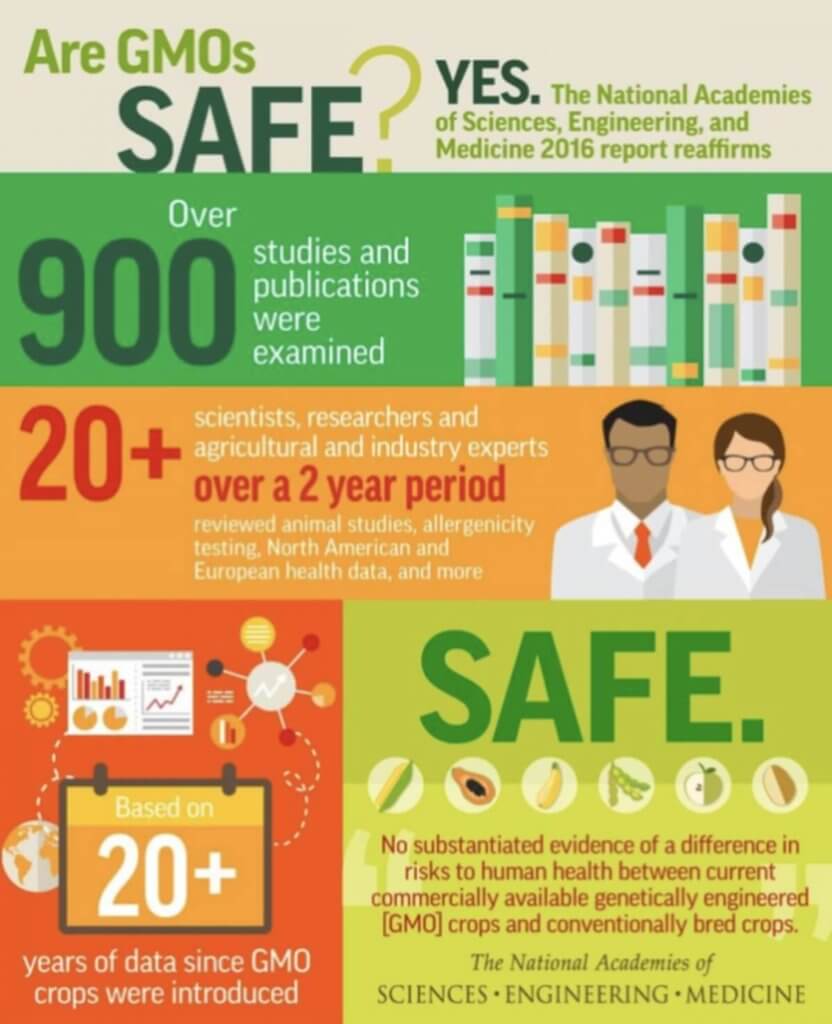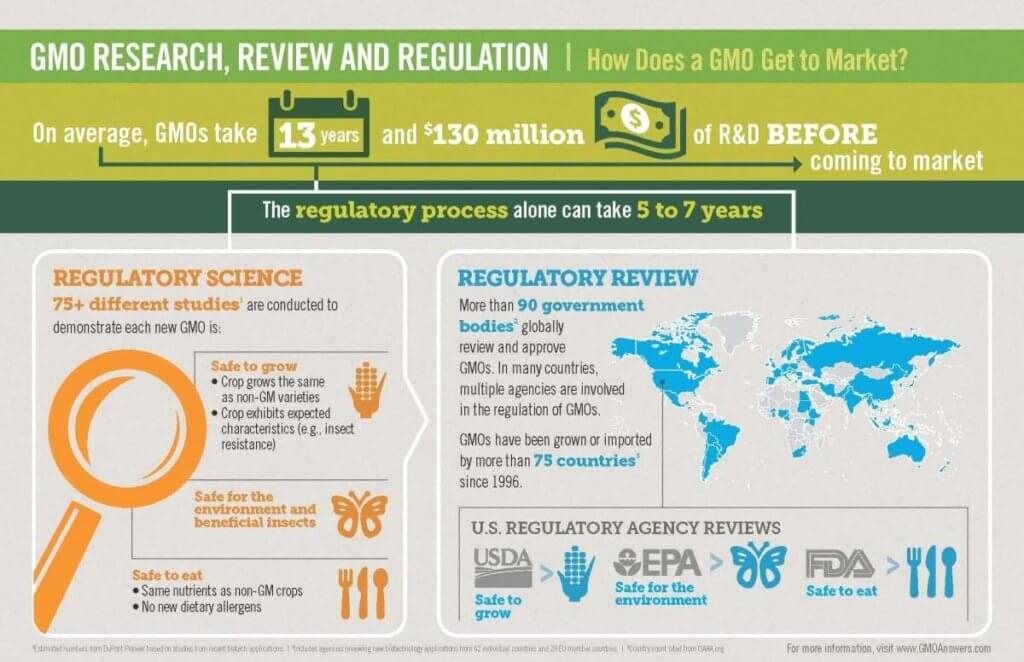Despite ample evidence that GMO crops do not threaten human health, a large portion of the general public remains skeptical of agricultural biotechnology. According to a June 2018 poll, just over 50 percent of US. consumers say they would avoid foods that were labeled as “bioengineered.” That contrasts with scientists who see bioengineered crops as safe and beneficial. A 2015 Pew poll found that 88% of American Association for the Advancement of Science (AAAS) scientists believe the technology is perfectly safe.
When it comes to medical advancements, however, Americans aren’t as apprehensive. In the same 2015 study, which also considered American opinions on biomedicine,The Pew Research survey asked the general public whether or not they felt the use of bioengineering to create artificial organs was an “appropriate use of medical advances” or was “taking such advances too far.” Fully 74% of adults say that bioengineering of organs is appropriate .
Consumers are clearly split about how they think about genetic engineering. GMOs (transgenics), which involves moving genes from one animal or plant into another, seems artificial to many people, a violation of nature’s order, especially when it comes to something as personal and visceral as food. It’s not clear how the public will respond to the introduction of CRISPR gene-edited crops, which are expected to hit the market in the coming years, but anti-GMO activists are beginning to sound the alarm about the alleged dangers of gene editing as well.
Yet the use of transgenics in biomedicine creates very little controversy, even though the process to develop a medical product is almost identical to the one used to create a GMO seed. Both are the result of very long and careful screening processes to find the right molecules and proteins, and the genes that code for them. In both cases, various organisms are engineered for use as factories to produce the engineered product. Bacteria are the preferred option, as they are the easiest to grow and scale-up for production. But depending on the complexity of the drug’s molecular structure, other organisms such as yeasts and mammalian cells can also be used to express the final product.
As one example, scientists use biotechnology to analyze new diseases and manufacture vaccines to protect against them. Harvard University chemist Jeff Bessen:
Many vaccines and top-grossing pharmaceuticals contain proteins as the main ingredient. Proteins are too costly and delicate to manufacture from scratch. But living cells must make proteins to survive, and they can be coaxed to produce medical proteins in bulk, requiring little more than the DNA instructions and sugary broth as fuel. Since these genetic blueprints must be inserted into the cells, many vaccines and drugs are technically the product of GMOs
 This graphic depicts how many vaccines are made using genetic engineering. Image Credit: GenScript
This graphic depicts how many vaccines are made using genetic engineering. Image Credit: GenScriptWhile the techniques used to modify the organisms in making drugs and creating new crops are similar, the intent couldn’t be more different. Pharmaceutical companies look to manufacture drugs intended to have deliberate effects on the biochemistry of their targets, to treat or cure a disease. Agricultural companies add traits to plants that will help farmers without harming consumers or the environment. The next step is to take the candidate genes and insert them into the appropriate host crop. Then begins the painstaking operation of selecting the organism or plant that expresses the desired trait.
This leads to the last commonality between biotech crops and drugs: both go through a multi-year approval process. The process for drug products ensures that it does what it is designed to do, with minimal side effects. Because these compounds are designed to have profound biological impacts, they have a more in-depth approval process. They must not only be shown to be safe, but effective for the condition they are targeted to treat.
The approval process for agriculture is far more limited in principle, supposedly only concerned with safety and substantive equivalence. The process confirms that the crop is as safe to eat or use as its non-GMO counterpart, and that it does not pose a risk to the environment. Currently only a few genetic changes are made to a crop, which ultimately result in the expression of well understood proteins. That makes checking for known allergens and digestibility a relatively straightforward process. These safeguards are doing their job, as the scientific consensus is quite clear: the currently approved GMO crops pose no greater health or environmental concerns than their non-GMO counterparts. But the approval process has been so politicized that it takes on average 13 years and $130 million to get a crop approved; the only bioengineered animal to be approved, AquaBounty’s sustainable salmon, took 17 years, and still is not on the market because of a political fight led by Alaska Senator Lisa Murkowski who fears the engineered Atlantic salmon will threaten the wild Pacific salmon.
Nonetheless, the public perceives biomedicine as much more palatable than crop biotechnology. The reasons are twofold. Most importantly, medical innovations have immediate, palpable impacts on public health. For example, diabetes, which was once a “death sentence” according to former FDA scientist Henry Miller, is now manageable for millions of diabetics thanks in part to inexpensive insulin mass produced with genetically-engineered bacteria. FDA-approved gene therapies are now available to mute the effects of leukemia and lymphoma, diseases that kill just over 40,000 people a year. Both treatments involve genetically engineering a patient’s immune cells to attack the diseases.
Research suggests that consumers are more willing to accept genetic engineering when they experience direct benefits. A 2016 study published in PLOS One found that 68 percent of consumers were willing to accept genetic engineering when used to improve human health. Consumer acceptance dropped to 49 percent when genetic engineering was applied to agriculture.
With the notable exceptions of vitamin-enhanced Golden Rice (still not in distribution) and the disease-resistant Hawaiian papaya, both of which were developed largely independently of multinational corporations, the agricultural applications of biotechnology have been predominantly designed to address the practical concerns of farming, such as controlling destructive insects and weeds. Herbicide-resistant and insect-resistant crops have given farmers more choices and reduced agriculture’s environmental footprint.
Consumers benefit, but indirectly in the form of significantly lower food prices for many products, according to the USDA. But it’s farmers who actually benefit from improved crop yields and lower costs. Beginning in the late 1990s, many organic food proponents and environmental groups have capitalized on consumer ignorance about genetic engineering, launching well-funded, anti-GMO campaigns. Aided by widespread media coverage, activists raised “unnecessary anxiety among consumers,” says University of California, Riverside molecular geneticist Alan McHughen, which gave rise to the ongoing controversy over crop biotechnology.
The Takeaway
Anti-biotech activists first tried to stifle genetic engineering in the late 1970s and early 1980s when the technology was used to develop the first biotech pharmaceuticals. They failed, experts say, because the medical benefits of the technology were tangible to the public. Research confirms that communicating consumer-focused benefits of current and new generation gene edited crops, including lower prices and increased nutrition, might quell unfounded fears of crop biotechnology, as it did with biomedicine. The authors of a 2018 study summarized what might be done:
[O]ur research points to the need for the GM industry to change how it’s promoting the products, and to begin producing foods that directly benefit consumers. The agricultural biotechnology industry needs to place consumer interests at the center of their focus, not only at the time of selling their products, but also during the research and development processes.
University of Saskatchewan agricultural economist Stuart Smyth speculates that the anti-GMO movement, by so fervently attacking GMOs, has galvanized scientists and science journalists to engage the public in conversation about crop biotechnology, which could also improve consumer acceptance.
As the public continues to learn about and experience the benefits of genetic engineering, claims about GMO “frankenfoods” could begin to fall on deaf ears. If that happens, the public may gradually embrace GMO crops and next-generation gene edited foods as they do bioengineered pharmaceuticals.






 English (United States) ·
English (United States) ·